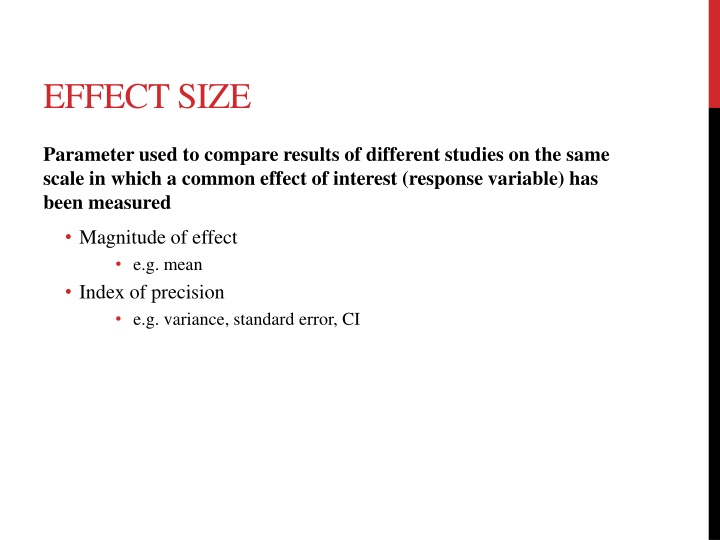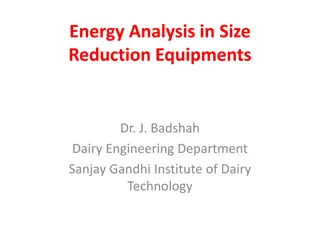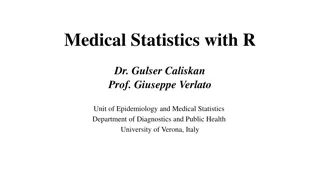
Different Measures of Effect Size in Research Studies
Explore the concept of effect size in research studies, including common measures like standardized mean difference and correlation, with a focus on comparing results across studies. Learn about the use of variance and mean difference to quantify treatment effects and associations between variables, along with alternative metrics and strategies to calculate effect sizes under different data distributions.
Download Presentation

Please find below an Image/Link to download the presentation.
The content on the website is provided AS IS for your information and personal use only. It may not be sold, licensed, or shared on other websites without obtaining consent from the author. If you encounter any issues during the download, it is possible that the publisher has removed the file from their server.
You are allowed to download the files provided on this website for personal or commercial use, subject to the condition that they are used lawfully. All files are the property of their respective owners.
The content on the website is provided AS IS for your information and personal use only. It may not be sold, licensed, or shared on other websites without obtaining consent from the author.
E N D
Presentation Transcript
EFFECT SIZE Parameter used to compare results of different studies on the same scale in which a common effect of interest (response variable) has been measured Magnitude of effect e.g. mean Index of precision e.g. variance, standard error, CI
VARIANCE Most common index of precision Standardizes unlike things Turns apples and oranges into juice
COMMON MEASURES OF EFFECT SIZE 1. Standardized mean difference Hedges d Log Response Ratio Correlation 2. Pearson s correlation 1. Others Contingency tables,
MEAN DIFFERENCE (PAIRS OF MEANS) When to use it? Quantify strength of treatment effect Standardized difference in mean used to adjust for difference scales in different studies VARIANCE, (n, std dev) What is it? Hedges d or g Log Response Ratio ln R = ln Y1 ln Y2
MEAN DIFFERENCE Hillebrand and Cardinale 2004 Eco Letters
CORRELATIONS When to use it? Looking at association between two continuous variables (regressions!) Variance not reported (Common!) But Z-score, t test, F statistic, 2can be transformed into correlation coefficients What is it? Pearson s correlation (Fisher s z-transformation) Variance depends on sample size only!
OTHER EFFECT SIZES Two x Two Contingency data When to use it? Compares two groups with observed accounts of two outcomes (e.g. 2 table) What is it? Rate difference Limited by magnitude of P Rate ratio Odds ratio
OTHER EFFECT SIZES Slopes from simple linear regressions
ALTERNATIVE MEASURES OF EFFECT SIZE Osenberg and St Mary 1998
OTHER METRICS OF EFFECT SIZE DON T PANIC!! We have the power to calculate effect sizes under a variety of distributions Normally distributed data Count data Proportions Diversity Shannon diversity variance can be calculated Non Standard or Unknown distributions
OTHER METRICS OF EFFECT SIZE CORRECTED EFFECT SIZES If covariates are known, can account for and adjust effect estimates Pros? Cons? Both
SENSITIVITY ANALYSIS What if things were different? Distribution type Adjust effect size? Inflate variance to incorporate error? Use n as variance? Make sure that the effect isn't because of the effect estimate!
CONCLUSIONS Why are there meta-analysis? The basic recipe is dangerously simple: extract estimates of the magnitude of effect (ei) and its variance (v(ei)) from each study, and use weighted statistical analyses (e.g., weight by 1/v(ei)) to estimate categorical means, or response surfaces, and their confidence limits. Osenberg and St Mary 1998






















